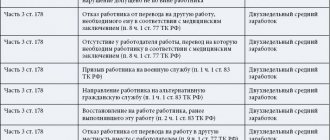Essence of the question
As a general rule, upon dismissal, an employee is paid compensation for all unused vacations (Article 127 of the Labor Code of the Russian Federation).
Vacation to be replaced by monetary compensation upon dismissal of an employee is calculated on the basis that full vacation is due to an employee who has worked a full year. It consists of 12 full months and is calculated from the day the employee starts working for a specific employer. For example, if an employee was hired on July 1, 2013, then he is granted leave for the working year from July 1, 2013 to June 30, 2014. The procedure for calculating compensation for unused vacation is established by the Rules on regular and additional vacations, approved by the People's Commissariat of Labor of the USSR dated April 30, 1930 No. 169 (hereinafter referred to as the Rules). Although this document was adopted more than 70 years ago, it is still applied (to the extent that does not contradict current legislation).
According to paragraph 28 of the Rules, if an employee has worked for at least 11 months that are subject to credit towards the period of work giving the right to annual paid leave, then compensation is due as for a full working year, that is, for 28 calendar days of leave. In this case, the reason for dismissal is not important.
Full compensation is also due to employees who have worked from 5.5 to 11 months if they are dismissed due to the liquidation of the enterprise, staff reduction and other reasons listed in subparagraph. “a” - “d” clause 28 of the Rules.
https://youtu.be/VjiPBtHWhYQ
New position of the department
Now Rostrud specialists have changed their position. The rationale is this. Paragraph 1 of the Rules stipulates: every employee who has worked for a given employer for at least 5.5 months has the right to receive another vacation. Regular leave is granted once per working year. The right to the next regular leave for the new working year arises for the employee after 5.5 months from the end of the previous working year. Thus, the entitlement to vacation is linked to the employee's working year.
Consequently, when dismissal due to liquidation or staff reduction, we are talking about the period (working year) for which leave is granted, and not about the total duration of work for a given employer. That is, full compensation for dismissal due to the liquidation of an enterprise or staff reduction is awarded to employees who have worked from 5.5 to 11 months in a working year. Accordingly, an employee who has worked for an organization for more than one year and 5.5 months and is dismissed due to staff reduction has the right to receive full compensation for unused vacation for the last working year. A different interpretation of this norm would mean an unequal position for employees who have worked in the organization for less than a year and those who have worked for a longer period, Rostrud specialists noted.
How to provide or receive leave when reducing staff?
The procedure for granting leave before reducing a position includes the following steps:
- The head of the organization issues an order regarding the upcoming reduction.
- An employee who is laid off is sent a notice (2 months before the expected date of dismissal).
- During these two months, the employee has the right to use the remaining vacation or receive monetary compensation for it upon dismissal. If it was chosen to take a vacation, the employee writes a corresponding statement, or goes on vacation according to the schedule, and the employer issues an order.
In what cases are they compensated?
Compensation for leave in case of staff reduction is paid to the employee in two cases:
- According to his application for monetary compensation instead of part of the vacation.
Moreover, the specified part of the vacation is not those days that the employee is entitled to by law, but those that are provided for in. Money can only be received for additional vacation, after using the main one of 28 days. - When an employee is dismissed from the company for any reason provided for by the Labor Code, incl. and to reduce staff or numbers.
Arithmetic features of calculation
To receive a fair payment for vacation time taken, you need to understand the intricacies of calculating periods for accruing money:
- Compensation is calculated for working years. The beginning of the period is the date of hiring.
- If an employee has not worked for a whole year at the company, vacation is compensated in proportion to the time worked - for full months.
- Surplus rule: taking into account an incomplete month depends on the number of days worked by the employee.
If less than half a month is worked, compensation is not accrued. If more, the calculation includes the whole month. - “11 in 12”: The labor committee acts on the side of the person being dismissed, therefore, according to the rules, if 11 months were worked in the year of dismissal, then the whole year is included in the calculation.
- On October 28, 2016, the Ministry of Labor explained how the surplus rule relates to the “11 to 12” rule. So, if more than 10.5 months were worked in a year, then they are counted as 11. And 11 months are counted for the year.
Therefore, more than 10.5 months of work will be counted when calculating vacation compensation for the year.
How to calculate?
When compensating for unused vacation upon dismissal due to staff reduction, the employee's average salary for the month is used.
The rules for calculating it are prescribed in the Regulations on the specifics of the procedure for calculating FWP of 2007.
In order to calculate compensation, you need to know the following values:
- The total number of days worked in the pay period.
- The total amount of accruals for the period.
- Average employee earnings (AEP) per month.
- Average daily earnings.
- Number of unused vacation days.
Procedure for calculating compensation upon dismissal
Upon dismissal, the employee receives compensation for vacation for all years of work in this company, that is, if there are vacation days left since 2014, they will be reimbursed with a cash payment. If the year is not fully worked, then the share of vacation days for each month of work is calculated:
Number of days of vacation due (28, 31, 35, 42, 56 days) / 12 months
It also takes into account how many days the employee worked in a month and is taken as:
- full month – more than 15 days
- month is not taken into account - less than 15 days
With a 28-day vacation for each month, the following is required:
2.33 vacation days = 28 days / 12 months
When calculating compensation, this number can only be rounded in favor of the employee, for example, to 3 days.
Counting days worked
The easiest way to count days is to take a production calendar and subtract working days from the total number of days in a year.
Time not included in the calculation of the ERP
But it’s hard to find super-responsible employees; everyone is human: they get sick, take time off, sit on juries, and use other reasons not to come to work.
Labor legislation establishes a number of periods that are not taken into account when calculating compensation.
All these excluded periods can be divided into 2 groups:
- The period of absence of an employee for which his average earnings were retained and already paid:
- illness on sick leave;
- maternity leave for childbirth and up to 3 years;
- a strike at an enterprise in which the employee did not participate;
- business trip;
- circumstances beyond the control of the parties (for example, natural disasters, etc.);
- training directed by the company;
- vacations, incl. additional;
- easy to use due to the fault of the company.
- Time of absence for other reasons during which SWP was not accrued - for example, on days off at the expense of the employee.
How to count work periods?
- Using the production calendar, we calculate the number of working days.
- We count the days that are not included.
- We subtract the second from the first - we get the actual time worked by the dismissed person.
We count accrued payments
After calculating the days worked, all payments made to the employee are calculated.
Article 139 of the Labor Code stipulates that only payments that are related to wages should be taken into account.
The entire list is contained in clause 2 of the Regulations on the calculation of FFP.
So, all salary income items are summed up:
- starting salaries and rates;
- various allowances for them;
- bonuses;
- additional payments for work in special (difficult) conditions or on holidays and weekends;
- any other “labor” income, both provided for by law and by the company itself.
When calculating, it does not matter what payment system the person worked under and how exactly he received his salary in hand - even income received in kind is taken into account.
What income is not taken into account for calculating the FFP?
Cash payments that were accrued to the employee in accordance with the right to maintain the SWP during periods determined by law (more about them below).
- Payments that have nothing to do with the remuneration system - i.e.
social guarantee payments at the initiative of the employer. For example, voluntary health insurance, payment for a mobile phone, food subsidies, dividends, daily allowances for business trips, etc. This category also includes funds issued to an employee who took days off to care for a disabled relative. - The last case is compensation for downtime at work due to the fault of the company or in the event of disasters and other reasons that do not depend on the will of the parties.
We calculate the average earnings
For calculating the SWP, the period is considered to be the working year - 12 months from the date of admission.
The SWP formula is as follows: we divide the actual amount accrued for the work by 12 (months).
We receive a salary wage, the amount of which, in the event of a reduction, is needed to pay severance pay and then another 3 months of maintenance while looking for a job.
We calculate daily earnings
To calculate vacation payments, we calculate another indicator - average daily earnings.
To do this, we divide the income for the time actually worked by the total number of days worked during the period.
Counting the days off
From the total number of allotted vacation days, we subtract those that the employee took.
The vacation days that are taken into account when calculating compensation include all those provided for in the Labor Code - both the minimum 28 days and additional ones for special working conditions and production.
Additional vacations provided for under an employment contract or company agreement are not taken into account. The employer may, at its discretion, compensate them, but such payments are not exempt from taxes and contributions.
We calculate vacation compensation
We calculate the number of remaining vacation days:
- For a year = the difference between the days allotted according to the Labor Code and the days off.
- For an incomplete year = (item 1 (per year)) divided by 12 months) and multiplied by the number of months worked
- For several years = point 1 (per year)) multiply by the number of years worked.
The resulting number of days must be multiplied by the employee’s average daily earnings, calculated earlier.
How is compensation for unused vacation calculated?{q}
To calculate compensation for vacation, you must be guided by the provisions of the Labor Code of the Russian Federation, in particular, Article 139, as well as the rules regulated by the People's Commissariat of Labor of the USSR dated April 30, 1930.
Formulas
K = SZD * KDN, where:
- K – amount of compensation.
- SZD – average salary per day of work.
- KDN – number of days of unused vacation.
Additional formulas for determining the necessary indicators will help you correctly use the calculation of compensation using the specified formula.
SZD = GD / 12 / 29.3, where:
- SZD – average salary per day of work.
- GD – actual income for the last 12 months of work.
- 12 is the number of months in a year.
- 29.3 – average number of days in a month.
KDN = OL * DO – DIO, where:
- KDN – number of days of unused vacation.
- OL – number of years worked.
- DO – number of vacation days per year under the contract.
- DIO – days of vacation used.
KDN = DO / 12 * OM, where:
- DO – number of vacation days per year under the contract.
- 12 – months of the year.
- OM – number of months worked.
Example
Petrov I.I. started his career at Salut LLC on March 2, 2020. Petrov was paid 45,000 rubles monthly for performing his job duties. On April 23, 2020, he received notice that his position was being eliminated. Accordingly, the last working day will be June 23, 2020. For each year worked, Petrov is entitled to 28 days of vacation. However, he did not fully exercise his right to vacation, and he still has vacation days left.
The actual amount of vacation is 67 days:
- 19 days in September 2020;
- 28 days in June 2020;
- 8 days in January 2020;
- 12 days in August 2020.
We will calculate compensation using the algorithm presented above.
By the time the position is reduced, Petrov will have worked for 3 full years and 4 months. The last month is incomplete, but given that 21 calendar days have been worked, which is more than half, vacation is also provided for this period. Let's find the amount of unused vacation for the full years worked: KDN = 3 * 28 – 67 = 17 days. In 3 years, a citizen could spend 84 days on vacation, but only took 67 days off, which means there are still 17 days left.- Let's determine the amount of unused vacation for the remaining 4 months: KDN = 28 / 12 * 4 = 9.3 days. It turned out to be a non-integer number of days. The enterprise has the right to independently decide whether to round the calculation result up or down. We will round up, so over the last 4 months Petrov has another 10 days of vacation.
- The total number of unsold days is: KDN = 17 10 = 27 days.
- Next, let's calculate the average daily earnings: ADD = (45,000 * 12) / 12 / 29.3 = 1,535.84 rubles.
- So, compensation for unrealized vacation is equal to: K = 1,535.84 * 27 = 41,467.58 rubles.
Thus, the cash payment for 27 days of vacation will be 41,467.58 rubles.
We suggest you read: Can bailiffs seize a credit card?
Additional compensation is due to those persons who do not work for 2 months after receiving notification of layoffs, but leave earlier by agreement of the parties. Accordingly, compensation is calculated for those working days that the employee would have worked if he had not quit earlier.
Formulas
DK = SZD * DS, where:
- DC – additional compensation.
- SZD – average salary per day.
- DS – number of working days before reduction.
SZD = GD / FD, where:
- SZD – average salary per day.
- GD – actual annual income (for the last 12 months of work).
- FD – actual number of working days for the billing period.
Example
Employee of Burya LLC Alyokhina A.V. received a notification on March 15, 2020 that due to staff reduction she would be fired on May 15, 2020. After talking with her boss, the citizen decided to quit earlier: April 2, 2020. Since the dismissal in this case is early, Alyokhina A.V. is entitled to receive additional compensation.
Let's calculate its size based on the amount of earnings over the last 12 months in the amount of 480,000 rubles.
- First, let’s determine how many working days there were on the production calendar over the last year of work. From April 2, 2020 to April 2, 2020, 246 days were worked.
- The average daily wage for the last 12 months is equal to: SZD = 480,000 / 256 = 1,951.22 rubles.
- Let's calculate the number of days for which the amount of money will be paid. The period from April 3 to May 15, 2020 includes 26 working days.
- The amount of additional compensation is: DC = 1,951.22 * 26 = 50,731.71 rubles.
Thus, the company will accrue 50,731.71 rubles in favor of the resigned employee.
Procedure for receiving compensation for unused vacation
According to Art. 140 of the Labor Code, the employer must pay all the money due to the employee on the day of dismissal - not only the salary for the month worked, but also vacation compensation and benefits in the amount of one average monthly income.
IMPORTANT. The dismissed person should not ask to calculate his vacation compensation, and the employer does not have the right to demand a statement from him, or refuse payment on this basis. The Labor Code contains extremely clear wording about the payment of all debts upon dismissal.
But sometimes accounting and personnel differ radically (especially in “gray” companies), and therefore it may turn out that the employee took all the “accounting” vacations, but in fact did not rest for several years.
In this case, the employee should still take care of his finances before the day of dismissal. He must draw up and officially submit a statement to the company's management.
The wording is free, like this:
To the Director of Yab LLC
from Ivanov I.I.,
resident: address.
Statement
In connection with the upcoming dismissal, I ask you to calculate my compensation for the vacation days that I did not use while working in the company from 07/07/14 to the present.
Ivanov I.I., signature, date
Documentation of compensation by the employer
On the employee’s last day of work, the employer draws up an order, on the basis of which the accounting department calculates the amount of compensation.
The law does not contain a strict form of the document, so the wording remains at the discretion of the personnel officer.
For example:
Order No. 160-uv
10/15/16 Moscow.
Based
Art. Article 126, 139, 140, 142, 178, 180 of the Labor Code of the Russian Federation,
as well as the dismissal order dated 10.15.16 No. 159-uv
I order:
make a full settlement with Ivanov A.A. and pay him all amounts due,
incl. compensation for unused vacation days for the period of work from 07/07/14 to 10/15/16.
Director of Yab LLC Ivolgin P.I.
Deductions from vacation compensation to the budget
According to Article 422 of the Tax Code, compensation for unused vacation upon dismissal is subject to taxes and fees in the general manner, i.e. from this amount personal income tax is paid - 13%, fees from the Social Insurance Fund, Compulsory Medical Insurance Fund and Pension Fund - 30%.
Reason for staff reduction
Staff reduction is a change in the staffing table by removing divisions or staffing units from it, that is, all employees working in this position or the entire division. The layoff procedure is quite complicated because employees do not want to lose their jobs and will try to defend their rights in court. Therefore, the reduction procedure consists of the following stages, taking into account periods:
| 1. generation of a reduction order | no less than 2 months |
| 2. informing laid-off workers taking into account the preferential factor and the offer of vacancies | no less than 2 months |
| 3. informing the trade union (if any) and the employment service | no less than 2 months |
| 4. payment of amounts due and issuance of all documents that are issued upon dismissal | on the day of dismissal |
| 5. upon registration of a laid-off person at the employment center within 2 weeks from the date of layoff, but not employed - payment of benefits | for the second month, as well as during the third month by decision of the employment service |
Important! When reducing staff, the employer is obliged to notify laid-off employees on seasonal jobs 7 calendar days in advance, and for an employment contract of up to 2 months - 3 calendar days in advance.
Thus, one of the important points in the reduction process that is important for the employee is receiving compensation for vacation, in which the employee is interested. Upon dismissal for any reason, the employee receives such compensation without fail, taking into account the entire time of work in the organization.
To avoid litigation with dismissed employees, a certain redundancy procedure must be followed.
Senior lawyer at Allen & Overy M. Blagovolina
| ★ Best-selling book “Accounting from scratch” for dummies (understand how to do accounting in 72 hours) > 8,000 books purchased |
Payments due to an employee upon layoff
In the event of a layoff, the employing organization must pay the dismissed employee:
- wages for the time he managed to work in the month of dismissal;
- compensation for unused vacation;
- severance pay - in general, in the amount of average monthly earnings (Article 178 of the Labor Code of the Russian Federation). Their own rules for the payment of severance pay have been established for seasonal workers and persons hired for a period of up to 2 months (Articles 296, 292 of the Labor Code of the Russian Federation).
Payments to the employee, including in relation to the amounts listed above, must be made on the day of his dismissal (Article 84.1, Article 140 of the Labor Code of the Russian Federation).
In addition, a laid-off employee is entitled to an average monthly salary for the period of employment, provided that the employee is not a part-time worker, a seasonal worker, or a person with whom an employment contract has been concluded for a period of less than 2 months. The period for which average earnings are paid cannot exceed 3 months after dismissal with severance pay included (Article 178 of the Labor Code of the Russian Federation). In other words, on the day of dismissal, the employee receives severance pay, which covers his average earnings for the first month of employment. If during this month and the next (two months in total) the dismissed person does not find a job, he will have the right to turn to his former employer for another average monthly salary. He will receive it for the 2nd month during which he was unemployed. And if during the 3rd month the employee is unable to get a job, for this month he will also be able to receive the average monthly salary from the former employer. But this will be the last payment.
For those who work in the Far North and equivalent areas, the paid period of employment after layoff increases to a maximum of 6 months, also including severance pay (Article 318 of the Labor Code of the Russian Federation).
Example of calculating the amount of compensation
The employee is leaving effective August 24, 2020. The duration of vacation in the organization is 28 days. Upon dismissal, the organization is obliged to calculate the amount of compensation within 5 days.
The employee's salary is 35,000 rubles, a bonus is accrued quarterly based on work results in the amount of the salary. The billing period has been fully completed.
Compensation for 5 days will be:
- Billing period: from August 1, 2020 to July 31, 2020.
- During this period the following wages were accrued:
35000 * 12 months + 35,000 * 4 quarters = 560,000 rub.
- Average daily earnings were:
560,000 rub. / (29.3 * 12) = 1592.72 rubles.
- The amount of compensation will be:
5 days * 1592.72 rub. = 7963.59 rub.
This amount is the employee’s income and is therefore subject to personal income tax (13% for residents):
7963.59 rub. * 13% = 1035 rub.
The compensation in hand will be:
7963.59 rub. – 1035.00 rub. = 6928.59 rub.
Dismissal due to reduction before the expiration of two months
An employee who is being laid off and has written consent, but there are no suitable vacancies for him, can quit early, that is, the employment contract with him can be terminated before the expiration of 2 months. This employee is paid additional compensation, taking into account the days that remain before the expiration of 2 months, for example, notice of layoff from August 24, 2020, but the employee quits from July 2, 2020 and the amount of compensation will be taken into account as if the employee worked until August 24 2020 (Part 3 of Article 180 of the Labor Code of the Russian Federation).
If this employee is dismissed not through layoff, but at his own request (Article 80 of the Labor Code of the Russian Federation), then in this case the employer does not pay compensation, as for dismissal due to layoff (Article 178 of the Labor Code of the Russian Federation).
Important! If an employee terminates the contract early during layoff, he receives: compensation in proportion to the time remaining before the expiration of the notice period and other payments under Art. 178 Labor Code of the Russian Federation.











